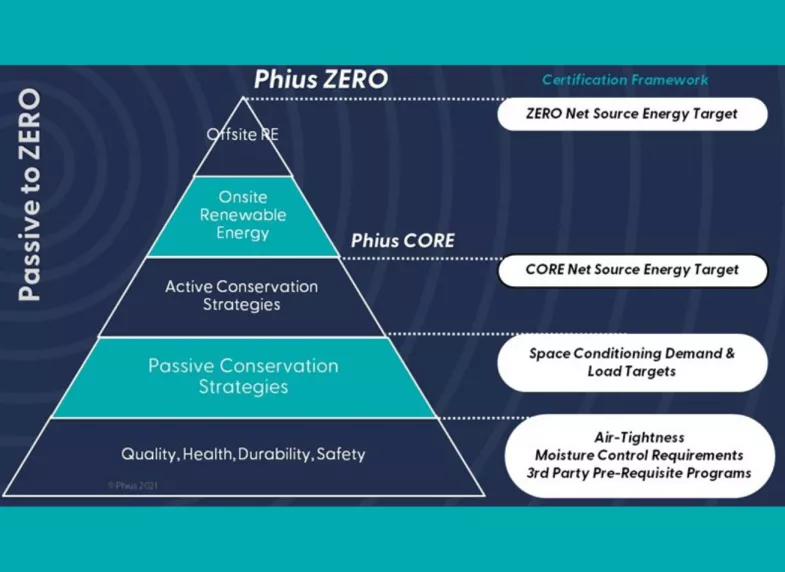
In this week's blog, Phius Associate Director Lisa White discusses the importance of setting proper performance targets for energy use modeling.
With the growing demand for high-performance building, local stretch codes, which often include building performance targets, are becoming more common.
Setting targets for the modeled energy use of buildings can be a powerful form of design guidance when executed correctly; the targets must allow for tradeoffs in design, creativity and innovation. At Phius, we have seen firsthand the unintended consequences that come alongside implementation of a performance-based standard – first with applying targets set for Central Europe in North America, and then through three iterations of our climate-specific passive building standard.
In general, we have found that not making targets climate-specific can lead to issues such as overheating and discomfort. They can also guide overinvestment in some measures, which may seem harmless, but directly correlates to additional up-front emissions, and could often be invested in other decarbonization strategies.
At Phius, we use absolute performance targets, i.e. setting a “do not exceed” limit for a given building. We set two main types of performance targets:
- Targets to reduce whole-building energy use that can be met with passive or active conservation strategies
- Targets on space conditioning loads that must be met with only passive conservation strategies.
The Phius Standard prioritizes passive conservation strategies. In order to guide investment, we used cost optimization to set limits on heating and cooling loads, both on a peak and annual basis. These four targets limit the amount of space conditioning energy that must be delivered to the space, independent of heating and cooling equipment choices.
We refer to the annual loads (kBTU/ft2yr) as demands, while we call the design loads (BTU/ft2hr) peak loads. Each has its benefits and own way of guiding passive design decisions.
To illustrate the difference between how annual and peak targets may affect design decisions, let’s consider window selection.
- If lowering the annual heating demand is the desired outcome, one may add windows on the south facade or increase the solar heat gain coefficient (SHGC) on their existing windows.
- If lowering the annual heat load is the desired outcome, one may specify increased thermal performance (lower U-value) for the windows.
If used in isolation, a low annual heat demand target would tell a designer that any increase in south glazing or SHGC is an improvement. Or if an inappropriate heating target is used, it may guide the designer too far toward passive heating strategies and lead to overheating in the cooling season. This is why appropriate cooling targets must accompany the heating targets. It’s a balance, and one without the other doesn’t provide that warning signal of “when to stop.” For example, it may make sense to dial back conservation measures for the heating season to reduce loads during the cooling season – netting an overall annual performance.
If the heat load target isn’t based on cost optimization, it may guide overinvestment in window performance or enclosure upgrades. But what’s the harm in that? Well, two things – 1) higher cost directly correlates to higher up-front carbon emissions, and 2) that additional investment may be better off spent on other decarbonization strategies, such as renewable energy or energy storage.
Now let’s consider lighting selection.
- If lowering the annual heating demand is the goal, improving lighting performance is actually detrimental, as it lowers the internal heat gain in the space and therefore increases heating demand.
- If lowering the annual cooling demand is the goal, thoughtful lighting design is required to reduce the internal load in the space.
If used in isolation, a low heating demand target would tell a designer that they do not need to improve lighting design. This is why both appropriate cooling targets and an appropriate whole-building energy use target are necessary.
So, if the right targets are set, designers can actually use them to guide design. But if inappropriate or extreme targets are set, it may end up like many other programs where targets are ignored and models are built just to show compliance.
Modeling
The issue of modeling protocol is critical with absolute performance targets. The target must be accompanied by accepted simulation tools (or required energy modeling capabilities) and must outline the input guidelines to verify compliance with those targets. The embedded calculation methodology and assumptions of a model can significantly shape the results, especially when you get down to passive building levels of performance. The annual heating is particularly sensitive, because the target is a small number that is the difference of two larger numbers – the gains and losses. You can model the exact same building in three different modeling tools and get completely different results if the assumptions don’t align. We have noticed particular sensitivity around methods and assumptions about heat loss to the ground, air infiltration models, lighting power densities, and miscellaneous internal heat gains.
Experienced energy modelers can “tweak” an energy model to show whatever results they want for compliance. This is why input guidelines and guardrails are required. Conversely, inexperienced modelers can inadvertently enter an input off by a factor of 10 and obtain wildly inaccurate results. That is why at Phius, we have both – detailed modeling protocol and a detailed model review during design and after construction. This review ensures that the model is following the modeling guidelines intended to be used in tandem with the performance targets. These three work in harmony and are equally important. This three-pronged approach has been verified in practice through measured data aligning very closely with the predicted model performance.
But setting absolute performance targets for all possible building types is tough. Starting with uniform per-square-foot numbers, we added climate sensitivity in 2015, sensitivity to building size in 2018, and sensitivity to unit density for 2021. We have confidence in the 2021 system for all kinds of residential buildings and for some nonresidential kinds with occupancy and ventilation patterns that are not dissimilar, such as schools and offices. But for many non-residential buildings, a one-off study to determine custom project-specific targets is needed.
Stay tuned for a follow-up blog on an alternative strategy being explored.
The Phius Standard is built on climate-specific, absolute performance targets coupled with modeling protocol and review, making it effective for as many building types as possible. But rest assured, we are continuously working to improve upon the system to make it more effective and widely applicable.
